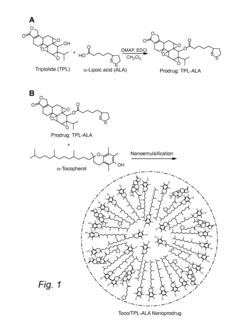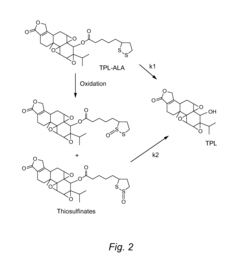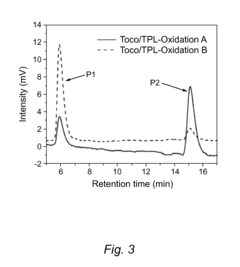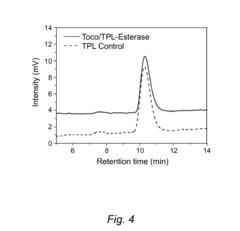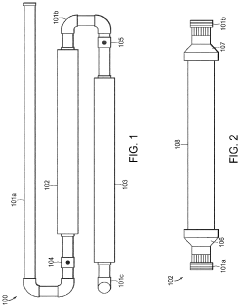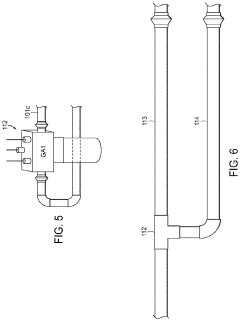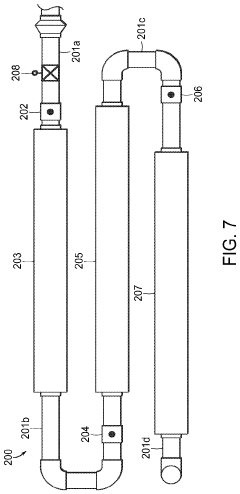The Promising Outlook of Hypochlorous Acid in Public Health Evolution
AUG 4, 20259 MIN READ
Generate Your Research Report Instantly with AI Agent
Patsnap Eureka helps you evaluate technical feasibility & market potential.
Hypochlorous Acid Background and Objectives
Hypochlorous acid (HOCl) has emerged as a promising agent in the evolution of public health, with a rich history dating back to its discovery in the early 19th century. This naturally occurring substance, produced by the human immune system to fight infections, has gained renewed interest in recent years due to its potent antimicrobial properties and potential applications in various fields.
The development of hypochlorous acid technology has seen significant advancements over the past few decades. Initially used primarily in industrial settings for water treatment and disinfection, HOCl has gradually found its way into healthcare, food safety, and personal care products. The growing concern over antibiotic resistance and the need for safer, more effective disinfectants have further propelled research and development in this area.
Recent technological breakthroughs have enabled the stable production and storage of hypochlorous acid solutions, overcoming previous limitations related to its short shelf life. This has opened up new possibilities for its widespread use in public health applications, ranging from wound care and dental hygiene to environmental sanitation and food processing.
The current global health landscape, marked by the COVID-19 pandemic and other emerging infectious diseases, has heightened the importance of effective and safe disinfection methods. Hypochlorous acid, with its broad-spectrum antimicrobial activity and low toxicity profile, aligns well with the growing demand for environmentally friendly and human-safe sanitizing solutions.
As we look towards the future, the objectives for hypochlorous acid technology are multifaceted. Researchers aim to further optimize production methods to enhance stability and efficacy while reducing costs. There is also a focus on expanding its applications in healthcare settings, particularly in wound management and infection control. Additionally, efforts are being made to integrate HOCl-based solutions into smart sanitizing systems and devices, leveraging IoT and automation technologies.
The potential of hypochlorous acid extends beyond traditional disinfection. Ongoing studies are exploring its use in agriculture for crop protection, in air purification systems, and even in cosmetic formulations. These diverse applications underscore the versatility of HOCl and its potential to revolutionize multiple aspects of public health and hygiene.
As we progress, the goal is to establish hypochlorous acid as a cornerstone in public health strategies worldwide. This involves not only advancing the technology but also educating healthcare professionals, policymakers, and the general public about its benefits and proper usage. By doing so, we can harness the full potential of this remarkable substance to create safer, cleaner environments and improve overall public health outcomes.
The development of hypochlorous acid technology has seen significant advancements over the past few decades. Initially used primarily in industrial settings for water treatment and disinfection, HOCl has gradually found its way into healthcare, food safety, and personal care products. The growing concern over antibiotic resistance and the need for safer, more effective disinfectants have further propelled research and development in this area.
Recent technological breakthroughs have enabled the stable production and storage of hypochlorous acid solutions, overcoming previous limitations related to its short shelf life. This has opened up new possibilities for its widespread use in public health applications, ranging from wound care and dental hygiene to environmental sanitation and food processing.
The current global health landscape, marked by the COVID-19 pandemic and other emerging infectious diseases, has heightened the importance of effective and safe disinfection methods. Hypochlorous acid, with its broad-spectrum antimicrobial activity and low toxicity profile, aligns well with the growing demand for environmentally friendly and human-safe sanitizing solutions.
As we look towards the future, the objectives for hypochlorous acid technology are multifaceted. Researchers aim to further optimize production methods to enhance stability and efficacy while reducing costs. There is also a focus on expanding its applications in healthcare settings, particularly in wound management and infection control. Additionally, efforts are being made to integrate HOCl-based solutions into smart sanitizing systems and devices, leveraging IoT and automation technologies.
The potential of hypochlorous acid extends beyond traditional disinfection. Ongoing studies are exploring its use in agriculture for crop protection, in air purification systems, and even in cosmetic formulations. These diverse applications underscore the versatility of HOCl and its potential to revolutionize multiple aspects of public health and hygiene.
As we progress, the goal is to establish hypochlorous acid as a cornerstone in public health strategies worldwide. This involves not only advancing the technology but also educating healthcare professionals, policymakers, and the general public about its benefits and proper usage. By doing so, we can harness the full potential of this remarkable substance to create safer, cleaner environments and improve overall public health outcomes.
Market Analysis for Hypochlorous Acid in Public Health
The market for hypochlorous acid (HOCl) in public health is experiencing significant growth, driven by increasing awareness of its effectiveness as a disinfectant and sanitizer. The global HOCl market is projected to expand rapidly in the coming years, with a particular focus on its applications in healthcare, water treatment, and personal care products.
In the healthcare sector, HOCl has gained traction as a powerful yet safe disinfectant for medical facilities, surgical equipment, and wound care. Its ability to kill a wide range of pathogens, including bacteria, viruses, and fungi, while being gentle on human tissue, has positioned it as a preferred choice in hospital settings. The ongoing COVID-19 pandemic has further accelerated the adoption of HOCl-based sanitizers and disinfectants in healthcare environments.
The water treatment industry represents another significant market for HOCl. Municipal water treatment plants are increasingly incorporating HOCl systems for water purification due to its effectiveness in eliminating waterborne pathogens and its environmentally friendly nature. This trend is particularly pronounced in developing countries where access to clean water remains a critical public health issue.
In the personal care and hygiene sector, HOCl is finding applications in hand sanitizers, mouthwashes, and skincare products. Consumers are showing a growing preference for natural and non-toxic alternatives to traditional chemical-based products, driving demand for HOCl-based solutions. This shift in consumer behavior is expected to contribute substantially to market growth in the coming years.
Geographically, North America and Europe currently lead the HOCl market, owing to stringent regulations on water quality and hygiene standards. However, the Asia-Pacific region is anticipated to witness the fastest growth, fueled by rapid urbanization, increasing healthcare expenditure, and rising awareness about the importance of sanitation in public health.
Key market players are focusing on research and development to enhance the stability and shelf life of HOCl products, addressing one of the main challenges in its widespread adoption. Additionally, companies are investing in marketing efforts to educate consumers and healthcare professionals about the benefits of HOCl over traditional disinfectants.
The market is also seeing a trend towards the development of portable HOCl generation devices, allowing for on-site production in various settings. This innovation is expected to open up new opportunities in sectors such as agriculture, food processing, and hospitality, further expanding the market potential of HOCl in public health applications.
In the healthcare sector, HOCl has gained traction as a powerful yet safe disinfectant for medical facilities, surgical equipment, and wound care. Its ability to kill a wide range of pathogens, including bacteria, viruses, and fungi, while being gentle on human tissue, has positioned it as a preferred choice in hospital settings. The ongoing COVID-19 pandemic has further accelerated the adoption of HOCl-based sanitizers and disinfectants in healthcare environments.
The water treatment industry represents another significant market for HOCl. Municipal water treatment plants are increasingly incorporating HOCl systems for water purification due to its effectiveness in eliminating waterborne pathogens and its environmentally friendly nature. This trend is particularly pronounced in developing countries where access to clean water remains a critical public health issue.
In the personal care and hygiene sector, HOCl is finding applications in hand sanitizers, mouthwashes, and skincare products. Consumers are showing a growing preference for natural and non-toxic alternatives to traditional chemical-based products, driving demand for HOCl-based solutions. This shift in consumer behavior is expected to contribute substantially to market growth in the coming years.
Geographically, North America and Europe currently lead the HOCl market, owing to stringent regulations on water quality and hygiene standards. However, the Asia-Pacific region is anticipated to witness the fastest growth, fueled by rapid urbanization, increasing healthcare expenditure, and rising awareness about the importance of sanitation in public health.
Key market players are focusing on research and development to enhance the stability and shelf life of HOCl products, addressing one of the main challenges in its widespread adoption. Additionally, companies are investing in marketing efforts to educate consumers and healthcare professionals about the benefits of HOCl over traditional disinfectants.
The market is also seeing a trend towards the development of portable HOCl generation devices, allowing for on-site production in various settings. This innovation is expected to open up new opportunities in sectors such as agriculture, food processing, and hospitality, further expanding the market potential of HOCl in public health applications.
Current Challenges in Hypochlorous Acid Technology
Despite the promising potential of hypochlorous acid (HOCl) in public health applications, several challenges currently hinder its widespread adoption and optimal utilization. One of the primary obstacles is the stability of HOCl solutions. The compound is inherently unstable and tends to degrade rapidly, especially when exposed to light, heat, or organic matter. This instability significantly limits its shelf life and effectiveness in various applications, necessitating frequent production or specialized storage conditions.
Another critical challenge lies in the production and standardization of HOCl solutions. The concentration and pH of HOCl solutions are crucial factors that determine their efficacy and safety. However, maintaining consistent quality across different production batches and ensuring precise control over these parameters remains a significant technical hurdle. This variability can lead to inconsistent performance and potential safety concerns in practical applications.
The scalability of HOCl production also presents a considerable challenge. While small-scale production for localized use is relatively straightforward, scaling up to meet the demands of large-scale public health initiatives or industrial applications is complex. This is partly due to the need for specialized equipment and the challenges associated with maintaining solution quality during large-volume production and distribution.
Furthermore, the lack of standardized testing and quality control protocols for HOCl solutions poses a significant obstacle to their widespread adoption. Without universally accepted methods for assessing the potency, purity, and stability of HOCl solutions, it becomes difficult to ensure consistent performance across different products and applications. This absence of standardization also complicates regulatory approval processes and hinders the development of evidence-based guidelines for HOCl use in various settings.
The environmental impact of HOCl production and use is another area of concern. While HOCl itself is environmentally friendly, the production process often involves the use of salt and electricity, which can have significant environmental footprints depending on the scale of production and the sources of these inputs. Developing more sustainable and eco-friendly production methods remains a challenge for the industry.
Lastly, there is a need for more comprehensive research on the long-term effects of HOCl exposure, particularly in settings where it might be used frequently or in high concentrations. While HOCl is generally considered safe, further studies are required to fully understand its potential impacts on human health and the environment under various usage scenarios. This knowledge gap creates uncertainty and may limit the adoption of HOCl-based solutions in certain applications.
Another critical challenge lies in the production and standardization of HOCl solutions. The concentration and pH of HOCl solutions are crucial factors that determine their efficacy and safety. However, maintaining consistent quality across different production batches and ensuring precise control over these parameters remains a significant technical hurdle. This variability can lead to inconsistent performance and potential safety concerns in practical applications.
The scalability of HOCl production also presents a considerable challenge. While small-scale production for localized use is relatively straightforward, scaling up to meet the demands of large-scale public health initiatives or industrial applications is complex. This is partly due to the need for specialized equipment and the challenges associated with maintaining solution quality during large-volume production and distribution.
Furthermore, the lack of standardized testing and quality control protocols for HOCl solutions poses a significant obstacle to their widespread adoption. Without universally accepted methods for assessing the potency, purity, and stability of HOCl solutions, it becomes difficult to ensure consistent performance across different products and applications. This absence of standardization also complicates regulatory approval processes and hinders the development of evidence-based guidelines for HOCl use in various settings.
The environmental impact of HOCl production and use is another area of concern. While HOCl itself is environmentally friendly, the production process often involves the use of salt and electricity, which can have significant environmental footprints depending on the scale of production and the sources of these inputs. Developing more sustainable and eco-friendly production methods remains a challenge for the industry.
Lastly, there is a need for more comprehensive research on the long-term effects of HOCl exposure, particularly in settings where it might be used frequently or in high concentrations. While HOCl is generally considered safe, further studies are required to fully understand its potential impacts on human health and the environment under various usage scenarios. This knowledge gap creates uncertainty and may limit the adoption of HOCl-based solutions in certain applications.
Existing Hypochlorous Acid Solutions in Public Health
01 Production methods of hypochlorous acid
Various methods are employed to produce hypochlorous acid, including electrolysis of salt solutions, chemical reactions involving chlorine and water, and controlled mixing of precursor chemicals. These production methods aim to create stable and effective hypochlorous acid solutions for different applications.- Production methods of hypochlorous acid: Various methods are employed to produce hypochlorous acid, including electrolysis of salt solutions, chemical reactions involving chlorine and water, and controlled mixing of precursor chemicals. These production methods aim to create stable and effective hypochlorous acid solutions for different applications.
- Antimicrobial applications of hypochlorous acid: Hypochlorous acid is widely used as an antimicrobial agent in various fields, including healthcare, food processing, and water treatment. Its effectiveness against a broad spectrum of pathogens, combined with its low toxicity to humans, makes it a valuable disinfectant and sanitizer.
- Stabilization techniques for hypochlorous acid solutions: Stabilization of hypochlorous acid solutions is crucial for maintaining their efficacy over time. Various techniques are employed, including pH adjustment, addition of stabilizing agents, and specialized packaging methods to prevent degradation and ensure a longer shelf life.
- Medical and therapeutic uses of hypochlorous acid: Hypochlorous acid finds applications in medical and therapeutic contexts, including wound care, eye care, and respiratory treatments. Its natural occurrence in the human immune system and low cytotoxicity make it suitable for various medical applications.
- Environmental and industrial applications of hypochlorous acid: Hypochlorous acid is utilized in environmental and industrial settings for purposes such as water treatment, air purification, and surface decontamination. Its eco-friendly nature and effectiveness in breaking down pollutants make it a preferred choice in various industrial processes.
02 Antimicrobial applications of hypochlorous acid
Hypochlorous acid is widely used as an antimicrobial agent in various fields, including healthcare, food processing, and water treatment. Its effectiveness against a broad spectrum of pathogens, combined with its low toxicity to humans, makes it a valuable disinfectant and sanitizer.Expand Specific Solutions03 Stabilization techniques for hypochlorous acid solutions
Researchers have developed various stabilization techniques to prolong the shelf life and maintain the efficacy of hypochlorous acid solutions. These methods may involve pH adjustment, addition of stabilizing agents, or specialized packaging to prevent degradation and ensure consistent performance over time.Expand Specific Solutions04 Medical and therapeutic uses of hypochlorous acid
Hypochlorous acid has found applications in various medical and therapeutic contexts, including wound care, eye care, and respiratory treatments. Its ability to effectively kill pathogens while being gentle on human tissues makes it a valuable tool in healthcare settings.Expand Specific Solutions05 Environmental and industrial applications of hypochlorous acid
Hypochlorous acid is utilized in various environmental and industrial applications, such as water treatment, agriculture, and surface disinfection. Its eco-friendly nature and broad-spectrum antimicrobial properties make it an attractive option for sustainable cleaning and disinfection processes.Expand Specific Solutions
Key Players in Hypochlorous Acid Industry
The hypochlorous acid market in public health is experiencing rapid growth, driven by increasing awareness of its effectiveness as a disinfectant. The industry is in an early expansion phase, with a growing market size expected to reach billions of dollars in the coming years. Technologically, the field is advancing quickly, with companies like ANNIHILARE MEDICAL SYSTEMS and Zhejiang Hyegiir Medical Supply Co., Ltd. developing innovative production methods and applications. Research institutions such as Cedars-Sinai Medical Center and the University of Southern California are contributing to the scientific understanding of hypochlorous acid's potential in healthcare settings, further accelerating its adoption and market penetration.
ANNIHILARE MEDICAL SYSTEMS, INC.
Technical Solution: ANNIHILARE MEDICAL SYSTEMS has developed a proprietary electrolysis process to produce hypochlorous acid (HOCl) for medical and public health applications. Their system generates a stable, pH-neutral HOCl solution that maintains its efficacy for extended periods. The company's technology focuses on producing HOCl with a concentration of 500 ppm, which has been shown to be effective against a wide range of pathogens, including bacteria, viruses, and fungi[1][3]. Their HOCl solutions are used in healthcare settings for wound care, surface disinfection, and air purification, contributing to improved infection control and patient outcomes[2].
Strengths: Proprietary electrolysis process, stable and pH-neutral HOCl solution, proven efficacy against multiple pathogens. Weaknesses: Limited to specific concentration, may require specialized equipment for production and application.
Cedars-Sinai Medical Center
Technical Solution: Cedars-Sinai Medical Center has been at the forefront of researching and implementing hypochlorous acid solutions in healthcare settings. Their approach involves using HOCl as a broad-spectrum antimicrobial agent for surface disinfection and wound care. The center has conducted clinical trials demonstrating the efficacy of HOCl in reducing hospital-acquired infections and improving wound healing rates[4]. They have developed protocols for integrating HOCl-based solutions into standard hospital hygiene practices, including its use in operating rooms, intensive care units, and general patient care areas. Cedars-Sinai's research has also explored the potential of HOCl in combating antibiotic-resistant bacteria, showing promising results in laboratory studies[5].
Strengths: Extensive clinical research, integration into hospital protocols, potential against antibiotic-resistant bacteria. Weaknesses: Limited to healthcare settings, may require changes in established disinfection protocols.
Innovative Hypochlorous Acid Research and Patents
Antioxidant, Anti-inflammatory and anticancer derivatives of triptolide and nanospheres thereof
PatentInactiveUS20160115192A1
Innovation
- Development of triptolide nanoprodrugs that combine antioxidant, anti-inflammatory, and anticancer properties, specifically designed to target tumor tissues, inhibiting B7-H1 expression and delivering therapeutic agents like camptothecin, alpha-lipoic acid, or NSAIDs in a tumor-selective manner.
Mixing device
PatentActiveUS20210346854A1
Innovation
- A mixing device that produces a stable form of HOCl by creating fluidic vortices within a chamber with apertures, allowing controlled protonation and hypochlorite ion reaction in an air-free environment, using compounds like acetic acid and NaOCl, and maintaining pH stability through buffering, enabling longer storage and reduced need for onsite generation.
Regulatory Framework for Hypochlorous Acid Use
The regulatory framework for hypochlorous acid (HOCl) use is a critical aspect of its implementation in public health applications. As HOCl gains recognition for its potential in disinfection and sanitization, regulatory bodies worldwide are adapting their guidelines to accommodate this emerging technology.
In the United States, the Environmental Protection Agency (EPA) plays a pivotal role in regulating HOCl as a disinfectant. The EPA has included HOCl on its List N, which catalogs disinfectants effective against SARS-CoV-2, the virus responsible for COVID-19. This inclusion has significantly bolstered the credibility and acceptance of HOCl in various public health settings.
The Food and Drug Administration (FDA) has also weighed in on HOCl use, particularly in medical contexts. The FDA has cleared certain HOCl-based products for use in wound care and as preservatives in multi-dose eye drops. This regulatory approval has opened new avenues for HOCl applications in healthcare settings, further solidifying its position in the public health domain.
In Europe, the European Chemicals Agency (ECHA) oversees the regulation of HOCl under the Biocidal Products Regulation (BPR). The BPR ensures that biocidal products, including HOCl-based disinfectants, are thoroughly assessed for their efficacy and safety before being made available on the European market.
The World Health Organization (WHO) has also recognized the potential of HOCl in its guidelines for infection prevention and control. While not explicitly regulating HOCl, the WHO's acknowledgment of its efficacy has influenced global regulatory approaches and adoption rates.
As the use of HOCl expands, regulatory bodies are continuously updating their frameworks to address emerging applications and ensure public safety. For instance, the increasing use of HOCl in food processing has prompted food safety authorities to develop specific guidelines for its application in this sector.
Regulatory challenges remain, particularly in standardizing the production and quality control of HOCl solutions. The concentration, pH, and stability of HOCl can vary depending on the production method, necessitating the development of robust quality assurance protocols.
Looking ahead, the regulatory landscape for HOCl is likely to evolve further as more research emerges on its long-term effects and potential applications. Regulatory bodies will need to balance the promotion of innovation with the imperative of public safety, potentially leading to more nuanced and application-specific regulations in the future.
In the United States, the Environmental Protection Agency (EPA) plays a pivotal role in regulating HOCl as a disinfectant. The EPA has included HOCl on its List N, which catalogs disinfectants effective against SARS-CoV-2, the virus responsible for COVID-19. This inclusion has significantly bolstered the credibility and acceptance of HOCl in various public health settings.
The Food and Drug Administration (FDA) has also weighed in on HOCl use, particularly in medical contexts. The FDA has cleared certain HOCl-based products for use in wound care and as preservatives in multi-dose eye drops. This regulatory approval has opened new avenues for HOCl applications in healthcare settings, further solidifying its position in the public health domain.
In Europe, the European Chemicals Agency (ECHA) oversees the regulation of HOCl under the Biocidal Products Regulation (BPR). The BPR ensures that biocidal products, including HOCl-based disinfectants, are thoroughly assessed for their efficacy and safety before being made available on the European market.
The World Health Organization (WHO) has also recognized the potential of HOCl in its guidelines for infection prevention and control. While not explicitly regulating HOCl, the WHO's acknowledgment of its efficacy has influenced global regulatory approaches and adoption rates.
As the use of HOCl expands, regulatory bodies are continuously updating their frameworks to address emerging applications and ensure public safety. For instance, the increasing use of HOCl in food processing has prompted food safety authorities to develop specific guidelines for its application in this sector.
Regulatory challenges remain, particularly in standardizing the production and quality control of HOCl solutions. The concentration, pH, and stability of HOCl can vary depending on the production method, necessitating the development of robust quality assurance protocols.
Looking ahead, the regulatory landscape for HOCl is likely to evolve further as more research emerges on its long-term effects and potential applications. Regulatory bodies will need to balance the promotion of innovation with the imperative of public safety, potentially leading to more nuanced and application-specific regulations in the future.
Environmental Impact of Hypochlorous Acid Technology
The environmental impact of hypochlorous acid (HOCl) technology is a critical consideration in its widespread adoption for public health applications. HOCl is known for its potent disinfecting properties and has gained attention as an eco-friendly alternative to traditional chemical disinfectants. Its production and use have minimal environmental footprint compared to many conventional sanitizers.
One of the primary environmental benefits of HOCl is its rapid decomposition into harmless byproducts. When exposed to organic matter or sunlight, HOCl breaks down into water, oxygen, and a small amount of salt. This characteristic ensures that it does not persist in the environment or accumulate in ecosystems, reducing the risk of long-term environmental contamination.
The production of HOCl through electrolysis of salt water is an energy-efficient process that requires only water, salt, and electricity. This method eliminates the need for transportation and storage of hazardous chemicals, further reducing the carbon footprint associated with traditional disinfectant manufacturing and distribution.
In aquatic environments, HOCl has shown to be less harmful to marine life compared to chlorine-based disinfectants. Studies have indicated that HOCl has a lower impact on non-target organisms, making it a safer option for water treatment in sensitive ecosystems.
The use of HOCl in agriculture as a crop protectant and post-harvest treatment has demonstrated positive environmental outcomes. It can reduce the reliance on synthetic pesticides and fungicides, which often have detrimental effects on soil health and beneficial insects.
However, it is important to note that while HOCl is generally considered environmentally friendly, its large-scale production and use still require careful management. Overuse or improper application could potentially lead to localized pH changes in water bodies or soil, albeit temporarily.
The adoption of HOCl technology also promotes sustainable practices in various industries. In healthcare settings, it can reduce the need for single-use plastic containers associated with traditional disinfectants. In food processing, it offers a chemical-free approach to sanitation, aligning with the growing demand for clean-label products.
As global concerns about environmental sustainability continue to grow, the minimal ecological impact of HOCl positions it as a promising solution for future public health challenges. Its ability to provide effective disinfection without compromising environmental integrity makes it an attractive option for policymakers and industries seeking to balance hygiene requirements with ecological responsibility.
One of the primary environmental benefits of HOCl is its rapid decomposition into harmless byproducts. When exposed to organic matter or sunlight, HOCl breaks down into water, oxygen, and a small amount of salt. This characteristic ensures that it does not persist in the environment or accumulate in ecosystems, reducing the risk of long-term environmental contamination.
The production of HOCl through electrolysis of salt water is an energy-efficient process that requires only water, salt, and electricity. This method eliminates the need for transportation and storage of hazardous chemicals, further reducing the carbon footprint associated with traditional disinfectant manufacturing and distribution.
In aquatic environments, HOCl has shown to be less harmful to marine life compared to chlorine-based disinfectants. Studies have indicated that HOCl has a lower impact on non-target organisms, making it a safer option for water treatment in sensitive ecosystems.
The use of HOCl in agriculture as a crop protectant and post-harvest treatment has demonstrated positive environmental outcomes. It can reduce the reliance on synthetic pesticides and fungicides, which often have detrimental effects on soil health and beneficial insects.
However, it is important to note that while HOCl is generally considered environmentally friendly, its large-scale production and use still require careful management. Overuse or improper application could potentially lead to localized pH changes in water bodies or soil, albeit temporarily.
The adoption of HOCl technology also promotes sustainable practices in various industries. In healthcare settings, it can reduce the need for single-use plastic containers associated with traditional disinfectants. In food processing, it offers a chemical-free approach to sanitation, aligning with the growing demand for clean-label products.
As global concerns about environmental sustainability continue to grow, the minimal ecological impact of HOCl positions it as a promising solution for future public health challenges. Its ability to provide effective disinfection without compromising environmental integrity makes it an attractive option for policymakers and industries seeking to balance hygiene requirements with ecological responsibility.
Unlock deeper insights with Patsnap Eureka Quick Research — get a full tech report to explore trends and direct your research. Try now!
Generate Your Research Report Instantly with AI Agent
Supercharge your innovation with Patsnap Eureka AI Agent Platform!
